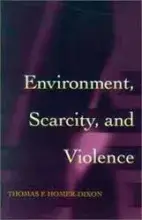Environment, Scarcity, and Violence

The Earth’s human population is expected to pass eight billion by the year 2025, while rapid growth in the global economy will spur ever increasing demands for natural resources. The world will consequently face growing scarcities of such vital renewable resources as cropland, fresh water, and forests. Thomas Homer-Dixon argues in this sobering book that these environmental scarcities will have profound social consequences — contributing to insurrections, ethnic clashes, urban unrest, and other forms of civil violence, especially in the developing world.
Winner of the 2000 Lynton Keith Caldwell Prize, American Political Science Association
Table of Contents
1. Introduction
Aim and Structure of the Book
Key Research Concepts, Methods, and Goals
2. Overview
The Critical Role of Environmental Resources
Sources of Environmental Scarcity
The Importance of Context
Pivotal Countries Ingenuity and Adaptation
3. Two Centuries of Debate
Neo-Malthusians versus Economic Optimists
The Distributionist Alternative
Thresholds, Interdependence, and Interactivity
Social Friction and Adaptive Failure
Appendix: How to Read a Systems Diagram
4. Environmental Scarcity
Three Sources of Scarcity Factors
Producing Scarcity
The Physical Trends of Global Change
5. Interactions and Social Effects
Interactions
Social Effects
Appendix: The Causal Role of Environmental Scarcity
6. Ingenuity and Adaptation
The Nature and Role of Ingenuity
Some Factors Increasing the Requirement for Ingenuity
Some Factors Limiting the Supply of Ingenuity
Conclusions Appendix: Can Poor Countries Attain Endogenous Growth?
7. Violence
Types of Violent Conflict
Four Further Cases
Urban Growth and Violence
Implications for International Security
Appendix: Hypothesis Testing and Case Selection
8. Conclusions
Notes
General Readings on Environmental Security
Index